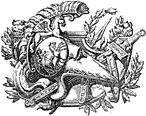| Bouchot navigation page, Preface, Chapter 1, Chapter 2, Chapter 3, Chapter 4, Chapter 5, Chapter 7, Chapter 8, Chapter 9, Index |
CHAPTER VI.
THE BOOK IN THE NINETEENTH CENTURY.
 OLITICAL imitators had not been found for the French Revolution in all the neighbouring countries of Europe, but its Greco-Roman art established itself, and by degrees was introduced into the studios of painters and the printing offices. Prud'hon, Gerard, Girodet, and later Desenne, without counting the younger Moreau and his contemporaries of the older regime, rallied to the new study, forming a school of illustrators and vignettists with which the publishers could resolutely advance. England followed suit with Flaxman, West, Fuseli, Barry, and a crowd of others. Among the publishers the powerful family of the Didots took first rank, and its members, at once type-founders, printers, booksellers, and savants of the first order, were the best fitted to direct an artistic and literary movement.
/ THE DIDOT FAMILY. p.219 /
When Napoleon crowned himself emperor of the French, the elders of the family had already brought about a number of perfections and discoveries in their profession by which their workshops had profited. François Ambroise, who died in the year of the Empire, had given an exact proportion to types, a free and elegant turn, but perhaps too regular and precise to be agreeable. He had also invented a press called the presse à un coup, in which the impression was taken by a single pull instead of being produced by a series of successive strikings. His brother, Pierre François, spoken of in the preceding chapter, was a type-founder and paper-maker at Essones, and counted among his official titles "printer to the Comte de Provence," as François Ambroise was to the Comte d'Artois.
OLITICAL imitators had not been found for the French Revolution in all the neighbouring countries of Europe, but its Greco-Roman art established itself, and by degrees was introduced into the studios of painters and the printing offices. Prud'hon, Gerard, Girodet, and later Desenne, without counting the younger Moreau and his contemporaries of the older regime, rallied to the new study, forming a school of illustrators and vignettists with which the publishers could resolutely advance. England followed suit with Flaxman, West, Fuseli, Barry, and a crowd of others. Among the publishers the powerful family of the Didots took first rank, and its members, at once type-founders, printers, booksellers, and savants of the first order, were the best fitted to direct an artistic and literary movement.
/ THE DIDOT FAMILY. p.219 /
When Napoleon crowned himself emperor of the French, the elders of the family had already brought about a number of perfections and discoveries in their profession by which their workshops had profited. François Ambroise, who died in the year of the Empire, had given an exact proportion to types, a free and elegant turn, but perhaps too regular and precise to be agreeable. He had also invented a press called the presse à un coup, in which the impression was taken by a single pull instead of being produced by a series of successive strikings. His brother, Pierre François, spoken of in the preceding chapter, was a type-founder and paper-maker at Essones, and counted among his official titles "printer to the Comte de Provence," as François Ambroise was to the Comte d'Artois.Of these two branches equally faithful to typography, Pierre Didot, son of François Ambroise, became the head on the death of his father. Born in 1760, he had studied his art with passion, and had merited the installation of his workshops in the Louvre, where he published a celebrated collection known as the Louvre editions, the chef-d'œuvre of which was the works of Racine. The splendid execution of this book, in three large folio volumes, was a true typographical revolution. Never in any country had scrupulous perfection of detail been joined to so masterly a knowledge of disposition and form of characters. The great artists of the Davidian school had the honour of seeing their drawings reproduced as illustrations, and those named above designed the fifty-seven plates with which the edition was adorned. Pierre Didot displayed a great affectation in only printing two hundred and fifty / p.220 / copies of his irreproachable and marvellous work, of which a hundred had proofs of the plates before letters. Published by subscription, the ordinary edition was issued at 1,200 francs, and with proofs 1,800 francs.
To these superb works Firmin Didot, his brother, added ingenious discoveries. Struck with certain difficulties of printing as well as of correction, he imagined the welding together of the types of a forme, when once obtained without faults, so as to avoid the trouble of new composition. This process, useless for books of small number, had a capital importance in the case of reimpressions of popular and successful works. He named this method stereotype, and from 1799 he published a Racine in 18mo by this method ; but the originality of the method, which he was the first to call stereotype, ended with its name, for the process had already been discovered by William Ged, a goldsmith of Edinburgh, in 1725, the first book produced in this manner being an edition of Sallust, printed in 1744, 8vo, "non typis mobilibus ut vulgo fieri solet, sed tabellis seu laminis fusis, excudebat."
This admirably directed house, we may indeed say this school of typography, formed with Renouard, Claye, Rignoux, and others, the greater number of the French publishers of the middle of the century. When the Czar Alexander went to Paris, he wished to do honour to the greatest French practitioners in the science of printing, in the persons of the brothers Pierre and Firmin Didot. But these were not the only ones. The sons of Pierre François, Henri and Pierre François II.—the latter specially applied himself to paper-making, under the name of Didot St. Leger— / THE DIDOTS AND ST. PIERRE. p.221 / followed in the footsteps of their father and uncle. Pierre François made at Essones an excellent paper, which he brought to the perfection of making it in endless rolls, such as are made to-day for rotary machines. Bernardin de St. Pierre retired to Essones about the end of the last century, and there married the daughter of Pierre François II. It is a curious coincidence that the same village contained at once the man whose works at the beginning of the century had so extraordinary a success and the great family of printers who had given definitive impetus to typographical work. It was in this tranquil circle that the author of "Paul and Virginia," at the age of sixty, sought repose ; that the publication of his book was resolved upon with all the luxury due to its success, with admirable type and with plates by Prud'hon and others. He added to it the Chaumière Indienne, written in 1790, on the eve of the Terror, which is one of the most delicate novels of the time.
The homely and sweet literature of Bernardin de St. Pierre, the heroic inventions of Girodet, Gerard, and Chaudet in the Greek or Roman style, the clever but severe typography of the Didots—such is the composition of the Book at the beginning of the century, and also its avowed tendency and good taste. Under Louis XV. the nymphs carried panniers ; Polyeucte had peruke and sword. It would be unbecoming not to give Juno or Venus the head-dress adopted in paintings and vignettes. At the time which now occupies us fashion in clothing directed designers also. The hair of goddesses was à la Titus ; the waist was under the arms ; golden circles were on the brow. Simple mortals walked / p.222 / naked on the roads, with plumed casques and superb shields. There were heroes putting forth their disproportioned arms, others raising their eyes to heaven in impossible attitudes. Such were all the vignettes, from Girodet to the humblest, the last, the most forgotten.
It happens, by an oddity of which the cause is vainly sought, that this classic and revolutionary school of David identifies itself so well with the Napoleonic epoch, then with the people of the Restoration, that it seems expressly made for them. At the same time, under Louis XVIII. and Charles X. the Romans and Greeks had not the bold carriage of their early days ; they became more citizenised, and assumed the air of the national guards of the kingdom of which later an excessive use was made.
England also had a splendid series of publishers and printers. From Boydell, Harding, the Murrays, Fisher ; from Bulmer, Bensley, Strahan, the Whittinghams, and Hansard, to our day, there has been an unbroken and constantly increasing line of clever, practical men, adorning the professions to which they devoted their energies, often realising that fortune which properly directed energies command. In the first half of the century a vast number of splendidly printed books were issued, ornamented in the most lavish manner with beautiful illustrations, engraved on steel or copper plates, and with delicate woodcuts. Book illustration in England may be said now to have reached perfection. When the banker-poet Samuel Rogers wished to bring out an illustrated edition of his works, he employed the two most capable artists of the time, Thomas Stothard and J. M. W. Turner ; and they produced an / ENGLISH BOOKS IN THE 19TH CENTURY. p.223 / admirable series of designs, which were exquisitely engraved by Finden, Goodall, and Pye. The work was printed by T. Davidson, in two volumes, octavo : the "Italy" in 1830 and the "Poems" in 1834 ; these two volumes, from the perfect harmony of the typography and illustration and their combined beauty, may be referred to as the perfection of book-making. A very charming series of volumes is found in the " Annuals," " Keepsakes," " Amulets," and similar annual publications, illustrated with beautiful steel plates by the best engravers. The splendidly printed and illustrated bibliographical works of Dr. T. F. Dibdin may also be mentioned. They extend to several volumes, and were printed by Bulmer and his successors Nicoll and T. Bensley, illustrated by engraved plates and woodcuts by F. C. Lewis and others. H. G. Bohn, besides the fine series known as " Bohn's Libraries," numbering over six hundred volumes, in every branch of literature, art, and science, published many finely illustrated books, and as a bookseller had the largest stock of his day. Charles Knight did marvels in popularising literature in his day. William Pickering published a long series of very beautiful books, and in conjunction with Charles Whittingham, printer, of the far-famed Chiswick Press, revived the Aldine or old-faced types ; one of the most beautiful of his publications was Sir Harris Nicolas's edition of Walton's " Angler," in two volumes, imperial octavo, with a very fine set of steel plates, designed by Stothard and engraved by Augustus Fox and W. J. Cooke, besides engraved vignettes and representations of fish drawn by Inskipp.
In Germany perhaps the most remarkable achievement of the century is the extraordinary series of volumes of English authors, now (1887) numbering 2,500, issued by Baron Tauchnitz, of Leipzig, which, although eminently popular in their character, are well and tastefully printed. Among the most notable of the printing and publishing houses of Germany, many of them combining the two trades, are J. G. Cotta, dating from 1640 ; Breitkopf and Härtel, dating from 1719 ; Justus Perthes, founded 1796 ; T. O. Weigel, 1797 ; F. A. Brockhaus, 1805 ; B. G. Teubner, 1811 ; W. Drugulin, 1829 ; J. J. Weber, 1834, etc. Germany has advanced with England and France in fine typography and illustration in their several kinds. The modern school of book illustration in Germany undoubtedly has its origin in the influence given to it by the designs of the artist Adolph Menzel, amongst which a series of two hundred illustrations to the works of Frederick the Great, engraved on wood by the Vogels, Unzelman and Müller, show him to be one of the most powerful and accurate draughtsmen of the century.
To return to France, a new literature arose that was to react against the Greek full of Gallicisms ; but the movement, in reversing the ancient state of things, in wishing to replace antiquity by the Middle Ages, old Romans by old French, completely changed the physiognomy of the Book. The engraved vignette and the copper plate of the seventeenth and eighteenth centuries were to lose their supremacy and to give way to etching and wood engraving, also a revival of the Middle Ages.
It is not sufficiently known that wood engraving, after the unfortunate attempts of Papillon in France,
/ WOOD ENGRAVING REVIVED. p.225 /
was restored in England by Thomas Bewick, who founded a school, of which, at the commencement of our century, Clennell and the brothers Thompson were members. One of the Thompsons went to France about the middle of the Restoration, doubtless with the hope of profiting by his art, and he offered to the Print
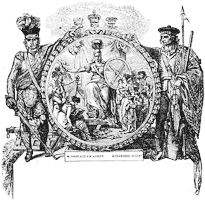
Department of the National Library the diploma of the Highland Society, a large folio wood block, very adroit and very curiously cut, after the drawing of the celebrated Benjamin West, and copied from Clennell's original block of the same subject. M. Duchesne, then Keeper of the Prints, speaks of this last process as of an apparition : "This print makes apparent the long- / p.226 / neglected and often reappearing art of wood engraving, which, though it could never equal copper engraving, nevertheless merits the attention of amateurs when a capable hand is exercised upon it." It was, we see, a curiosity then, this relief cutting, of which the resurrection was to give an enormous impulse to the Book from the facilities of printing and the economies realised by the possibility of intercalation in periodicals. In fact, metal printing necessitated so much trouble, more for engraving than for the impression. With wood blocks surrounded by type the ordinary press sufficed. The Magasin Pittoresque, which was commenced in 1833, and the success of which from the first was very great, was born of these new combinations. Before it the Messager Boiteux of Strasbourg and other popular almanacs progressed very well with their illustrations on wood. A kind of firm of engravers, at the head of which were Best and Andrew, undertook the illustrations of the Magasin Pittoresque. In a few years progress was immense, other publications came into existence, and a definitive return was made to the vignette in relief. The French illustrated paper preceded our Illustrated London News by nine years.
Lavish use was now made of wood engraving, which had thus been suddenly revived in the very midst of the new romantic effervescence, amid a war of books, which, in order to please, had above all to captivate the eye, reacting at once against the spirit and the art of the Restoration. Never before had artists to such an extent taken active part in a purely literary warfare. All the fantastic tendencies of young France were embodied in the lame and halting lines of the time and / ROMANCE IN THE NINETEENTH CENTURY. p.227 / similar wretched doggerel. Doubtless the leaders of the school did not go quite so far, and their reputation even suffered from such theories ; but, as always happens in such cases, the disciples outstripped their masters.
The brothers Johannot were the first to join in the fray, under the flag of the poets and others of the romantic school, such as Victor Hugo, De Vigny, Paul Lacroix, George Sand, and Devéria, most ruthless of
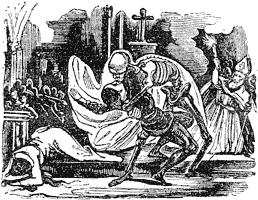
illustrators. The last-named had designed vignettes on wood, of all others, for Baour-Lormian, that is to say for the foe of the new ideas, at once the interpreter of Ossian and the bourgeois bard, full of fire and fury against everything in turn. The Légendes, Ballades, et Fabliaux, illustrated by Devéria in 1829, although a sort of compromise with the lovesick swains of mediæval times, did not escape the shafts of ridicule.
In the midst of this movement the Book became democratic ; it was printed on sugar-paper for reading- / p.228 / rooms and scullery maids. The generation of romancists diffused its paper-covered works, printing a thousand copies and selling five hundred with great difficulty. Poets publishing five hundred were happy with a sale of two hundred and fifty. Unheard-of titles were then needed to catch the eye, ridiculous and ghastly frontispieces to tickle the fancy of the riffraff. Paul Lacroix called himself the "Bibliophile Jacob," and invented surprising headpieces and foolish designs. And then, as in the fifteenth century, as in the old times, certain signs become popular with the reading public. In the place of the Doctrinals, Complaints, and Disputes, so common in the titles of those epochs, new fancies spring up and have their day. Eccentric devices recommend romantic trash, in which the assassin's dagger, blood, and the horrors of the tomb have replaced the insipid fantasies of the fallen regime. Pétrus Borel, the werewolf, a sort of historic ghoul prowling about the graveyards, enjoyed a monopoly, as it were, of the ghastly titles and contents of this charnel-house literature ; it was for his Champavert, published in 1833, that Gigoux composed a kind of Bluebeard surrounded by female skeletons, that opened the eyes of publishers to his value as a vignettist.
Although he threw himself soul and body into the romantic movement, the young artist did not alone design subjects called "abracadabrants," following the neologism of the time, any more than the booksellers only published romances. An attempt was made, by publishing them in parts, to still further popularise the old writers at all harmonising with the current taste. The publisher Paulin thus issued the Gil Blas / GIGOUX'S " GIL BLAS." p.229 / of Le Sage, with illustrations in the text by the younger Gigoux, of which the best was hoped. The history of this celebrated enterprise has been written by the artist himself in the curious Causeries published recently by him, fifty years after his work on Gil Blas ; and this interesting view of an epoch already far distant gives us in a few words the ordinary economy of these popular impressions in parts.
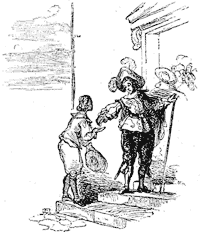
It appears that Paulin, publisher in the Rue de Seine, not being very well off, had associated himself with a man of business named Dubochet, who had before made an enormous fortune with gas. The two represented fifteen thousand to twenty thousand francs, and they ordered a hundred drawings on wood from the young artist. He set to work with precaution, for Dubochet / p.230 / was hard to please, without knowing much about the business, and fined the engravers for the least faults. Gigoux set himself to give his compositions in simple line, without complicated shadows, so as to allow the wood-cutters to preserve a free outline. It was nearly the same thing as the process of the old artists of the fifteenth and sixteenth centuries, of Vostre and Holbein : true engraving in relief. The success of the first sheets was extraordinary ; new vignettes were ordered from Gigoux ; in place of a hundred they wanted three hundred, then four hundred ; then at the end of the work they counted six hundred at least. Money filled the chests of the firm, but when the artist claimed a small share of the benefits, they laughed in his face.
Properly speaking, it was the first serious attempt at illustration by the recovered method of engraving in relief, but it was not the only one. Curmer, the publisher of the Rue Richelieu, prepared a Bible in 1835 and several other volumes, among which were the "Paul and Virginia" and the Chaumière Indienne of Bernardin de St. Pierre. He had also collected around him a circle of artists that included Wattier, Devéria, and Meissonier, who was the most perfect and correct of the designers on wood. Meissonier designed very soberly, without effects of light, little scenes admirably cut by an engraver named Lavoignat, a master in the largest sense of the word. Curmer wrote in 1835 in the preface to one of his books, "We hope we have raised a monument to wood engraving. It is easy to judge of the resources presented by this art. We are compelled to have recourse to England to accomplish our work. Peace to willing publishers !"
Curmer acknowledges the importance of English specialists in this new process for vignettes, and the willing publishers were not wanting ; they came from all parts. He himself did not stop on the way ; he continued his work on a large scale ; and Charles Blanc was able to say of him later, as well as of Furne,
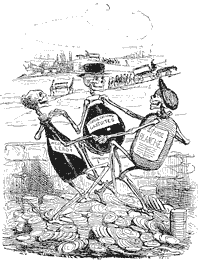
" He desired to illustrate books for everybody, as the great booksellers of the last century had illustrated their rare editions for a small number of privileged persons." But he did not always confine himself to wood engraving ; he also employed etching and lithography. These, requiring separate printing, did not / p.232 / make intercalation with the text any easier than engraving with the burin ; but they served to illustrate periodicals, the Charivari and L'Artiste, as well as some books, where they replaced the engraved plates of the preceding century. At the same time, the latter process was not altogether neglected ; about 1840 it was revived, and steel was used in place of copper, as it better resisted repeated impressions. The publisher Furne, while he employed wood engraving, adorned with separate plates on steel his better publications. For him worked Raffet, one of the romanticists enamoured of the Napoleonic epic, which he had popularised, with Charlet and Bellangé, by the pencil, wood, and lithography. Raffet had transferred upon wood, as if in play, the three hundred and fifty-one vignettes of the Histoire de Napoléon, by De Norvins, which would to-day suffice for the glory and reputation of many artists. In fact, the analytical and inductive spirit of the artist led him to leave nothing to the chances of inspiration and commonplace of illustration. He laboriously reconstituted, fragment by fragment, the physiognomy of the "old army ;" and imbued with the perfect science of detail, he allowed his pencil full play in bold and luminous inventions, where may be seen again, with their peculiar appearance, the heroes of other days, the soldiers of the Rhine and Italy, of Austerlitz and Waterloo.
A truly lively period was that of 1840, a living and unthinking generation. By the side of those great artists of whom we have spoken, and who will be more admired some day, there were the fantasists Traviès and Daumier, who adorned the illustrated journals with / BOOK ILLUSTRATION IN 1840. p.233 / innumerable sketches, and Grandville and Gavarni, one caricaturing animals in a celebrated book, Les Animaux Peints par Eux-mêmes, which is more than a chef-d'œuvre ; the other coolly studying the vices and faults of his time, with the precision of an anatomist, in Les Anglais Peints par Eux-mêmes of Labedollière, in
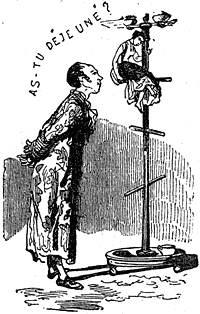
|
Presently photography came, which was to reverse completely the conditions of illustration of the Book by the numerous means of reproduction to which it gave birth. Then wood engraving entered on a new phase, a complete transformation of its ordinary terms, under the influence of Gustave Doré. Little by little it had been attempted to render in relief that which engraved plates only had hitherto done. Black, half-tints, lowered tones, were tried where formerly a simple line, bold and spirited, signified everything. The house of Hachette, founded by one of the normal teachers of the liberal movement, at the beginning of the century, was, together with Lahure, the promoter of relief so inclusive and practical. The / p.234 / numerous periodicals of these publishers spread the taste afar. England, for its part, entered on the road, followed by America and Germany. To-day wood engravings have reached perfection, finesse, and suppleness ; but they are not, properly speaking, engravings on wood.
We have seen that French publishers were largely
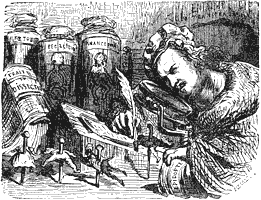
indebted to English wood engravers for their blocks. The school that was established by Bewick and his pupils made enormous progress. From the " Fables," published in 1818, we reproduce an illustration as also a specimen from the second volume of the " British Birds." Luke Clennell was one of the most distinguished of Bewick's pupils ; and he made some ex- / ENGLISH ILLUSTRATION OF THE 19TH CENTURY. p.235 / cellent blocks, among them the illustrations to an edition of Rogers's "Poems" (1812), engraved from pen-and-ink drawings by Thomas Stothard. It was Stothard's opinion that wood engraving best reproduced pen-and-ink drawings. Other pupils of Bewick were J. Jackson, John Thompson, who engraved Harvey's beautiful illustrations to Milton and Hender-
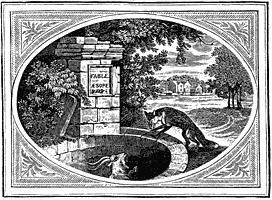
son's " History of Wines," S. Williams, Orrin Smith, Robert Branston, and C. Nesbit. The most prolific and perhaps the most popular book-illustrator of the century in England, was George Cruikshank, who engraved most of his own designs on wood, steel, or with the etching needle ; the catalogue of his works by Mr. G. W. Reid, formerly keeper of the Prints in the British Museum, occupies three quarto volumes. The designs of " Phiz," as H. K. Browne called himself, / p.236 / largely contributed to the popularity of the works of Charles Dickens ; and the mere mention of Richard Doyle and John Leech will recall the palmy days of Punch, although both of these artists did excellent work in book illustration. From the days of the Bewicks to the present wood engraving has formed the most widely used means of illustration in England and the United States. Its adaptability to the printing machine renders it admirably suited to the production of books in large numbers and at low expense.
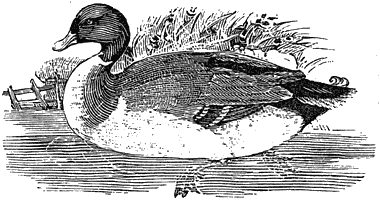
Without it we could not have our Graphics and Illustrated News, nor the floods of cheap but splendidly illustrated magazines which are appearing on both sides of the Atlantic. True, many of these blocks are due to the "processes" which photography has made available, but they are nevertheless the outcome of wood engraving. We cannot leave this subject without mentioning the admirable " Treatise on Wood Engraving," by W. A. Chatto, with numerous illustrations, published originally by H. G. Bohn in 1839 and since reprinted.
In our days the great Paris publishers have returned to the books of the eighteenth century, ornamented with vignettes on copper ; many of them purely and simply imitate by photographic processes the pretty editions of Eisen and Moreau, but they do not merit the name which they bear. As to those whose specialty is handsome books with figures by contemporary artists, those who always are in the front, as the Mames, Quantins, Hachettes, Plons, Jouausts,
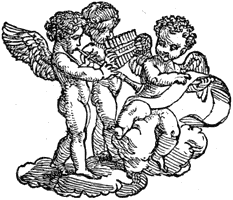
of France ; the Longmans, Murrays, Macmillans, Kegan Pauls, Cassells, and Chattos of England ; the Harpers, Scribners, Lippincotts, and Houghtons of the United States, they are to us what the ancients of whom we have spoken were to their contemporaries. Now the processes of illustration are without number : wood, metal, heliogravure, phototype, and others. And if the mechanical means, if the heliogravures, have at present the importance claimed, they by no means add to the intrinsic value of wood engravings, but to the rapidity and economy of their manufacture. The Book, the true / p.238 / Book, has nothing to do with all these inventions, and may well confine itself to the burin or the relief block.
But as regards the Book, properly so called, it never was the object of more excessive care or of more unfortunate precipitation. It may be remarked that works least destined to live in the libraries, those thousands of lame pamphlets on questions of small provincial erudition or the cap-and-sword romances, are ordinarily the best and most carefully printed, in opposition to other more important works composed in heads of nails and on worn-out paper. There are in reading-rooms a good number of pamphlets that will not be found in fifty years, and will be worth their weight in banknotes, even if dirty and tattered, on account of their intrinsic value.
